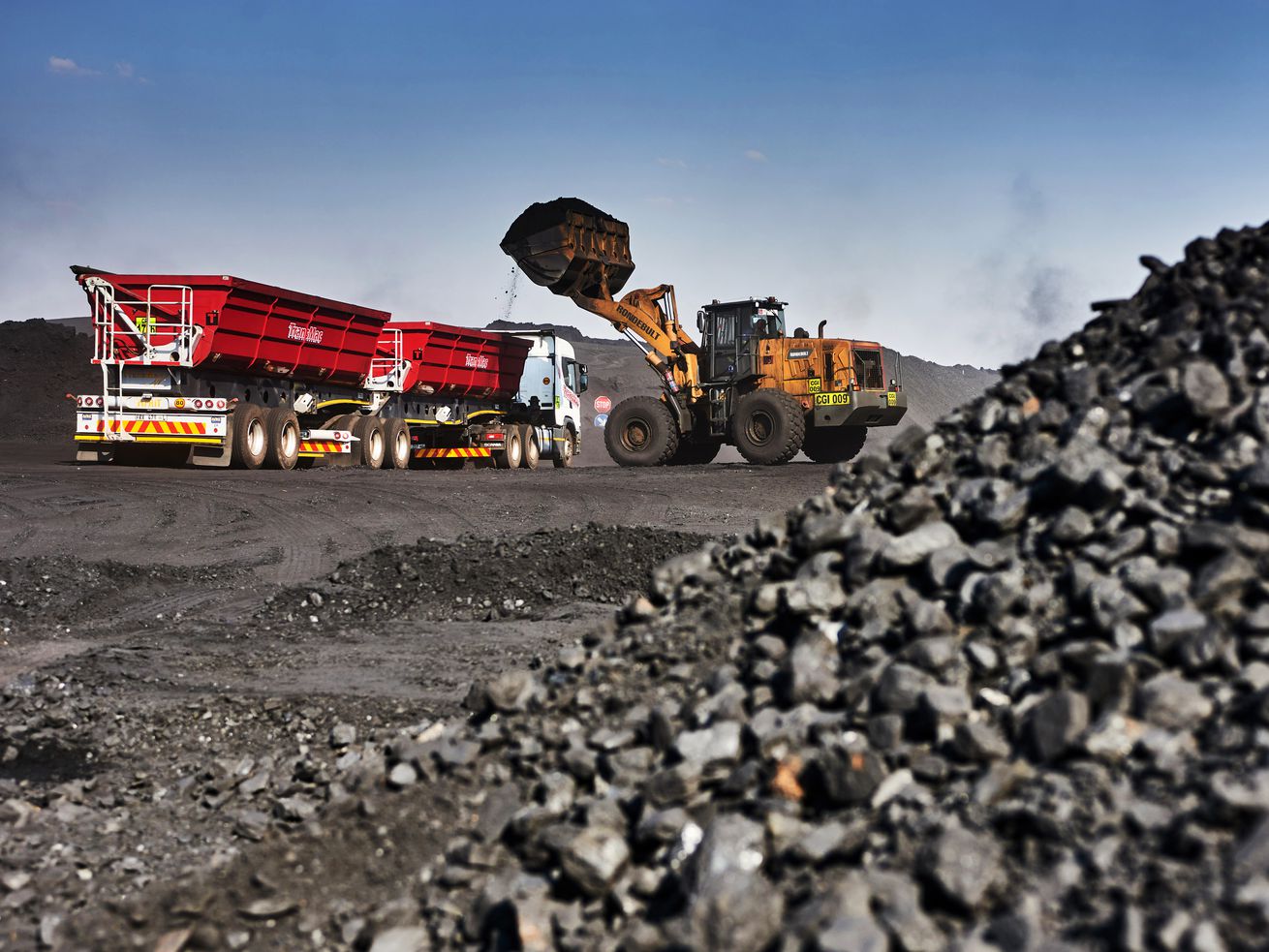Should coal, oil, and natural gas still be part of the answer for the world’s poorest in an era of climate change?
The COP27 climate change negotiations that wrapped in Egypt this month broke a critical impasse on paying for the consequences of climate change. But language in the concluding agreement around the cause — burning fossil fuels — was once again vague and weak.
It calls for a “phasedown of unabated coal power and phase-out of inefficient fossil fuel subsidies,” rather than a stronger, more explicit commitment to end all fossil fuel consumption as some countries and activists wanted.
The watered-down final text was due in large part to pressure from the major oil exporters. But some delegates from developing countries were making the case that they deserve financing and support to use fossil fuels in order to escape poverty, to improve their standards of living, and to cope with the consequences of climate change already underway. Though these places are now seeing floods, heat waves, and drought worsened by rising temperatures, their residents are also growing frustrated by the slow progress and broken promises of international climate talks.
“If you are going to tell us to leave our resources in the ground, then you must be prepared to offer sufficient compensation, but I don’t think anyone has yet come out to make such an offer,” Maggy Shino, Namibia’s petroleum commissioner, told Reuters during the meeting.
Wealthy countries have promised to pool billions of dollars every year to help developing countries transition to cleaner energy, but have failed to live up to their commitments. One pledge in particular aimed to provide $100 billion per year by 2020, which still hasn’t been met. By one estimate, developing countries will need $2 trillion per year by 2030 to address the causes and effects of climate change.
“They have all made announcements of sorts and proclaim loads of new money for renewables,” Carlos Lopes, a professor at the University of Cape Town and the former head of the United Nations Economic Commission for Africa, told Vox in an email. “The real picture though is that there is over-promising and under-delivery for these transitions.”
Development banks and international funding groups like the World Bank have dialed back their financing of fossil fuels in developing countries in recent years, slowing the construction of new power plants running on coal and natural gas. The European Investment Bank says it “no longer supports traditional fossil fuel energy projects.”
Meanwhile, some wealthy countries have increased their fossil fuel use and expanded exports in recent months following Russia’s invasion of Ukraine and the ensuing turmoil in global energy markets. Many governments are also eager to give their economies a boost with cheap fuel as they emerge from the Covid-19 pandemic.
The situation now is that rich countries are ramping up their use of the dirtiest fuels, while poorer countries are finding it harder than ever to extract, use, and sell their own resources. Effectively, it’s shifting the burden of reducing greenhouse emissions to those least able to afford it. That’s why some argue that the world’s poorest countries should receive more money to pursue their energy ambitions, regardless of the fuel source.
Why the poorest regions of the world should have the leeway to burn more coal, oil, and natural gas
The core injustice of climate change is that the people who often stand to suffer the most from the effects of rising temperatures contributed the fewest greenhouse gas emissions. Meanwhile, those that burned the most fossil fuels have accumulated the wealth to insulate themselves from many of the consequences of climate change.
Between factors like sea level rise and higher temperatures, climate change has already rendered parts of the world unlivable. Coping with these effects is energy-intensive and expensive. More frequent and intense heat waves have made cooling a lifesaving necessity in some regions. And for developing countries, this is all happening on top of existing poverty, inequality, and the legacies of past exploitation.
/cdn.vox-cdn.com/uploads/chorus_asset/file/24242160/GettyImages_1240700822a.jpg)
Aamir Qureshi/AFP via Getty Images
Another factor is that the fossil fuel power plants and infrastructure already in place in poorer countries were often built by multinational corporations headquartered in rich countries or by the very development banks now turning against them. Now governments like the European Union are considering policies like a border adjustment carbon tax, which would impose tariffs on goods from countries with dirtier energy sources. That would effectively penalize imports from many developing countries.
Yet in terms of greenhouse gas emissions, developing countries and their energy demands barely register. The state of Colorado, with a population of 5.8 million people, uses more than 52 terawatt-hours of electricity per year. The 13.7 million people of Rwanda use about 6 TWh of electricity per year.
According to the International Energy Agency, 770 million people, mostly in Africa and Asia, don’t have access to electricity at all, even for things like water purification and lighting. In the past decade, the increasing popularity of SUVs was one of the largest drivers of the rise in greenhouse gas emissions, driven mainly by tastes in wealthy countries. So fossil fuels go furthest in improving the standard of living and quality of life in countries that have the least energy to begin with.
Vijaya Ramachandran, director for energy and development at the Breakthrough Institute, co-authored a report earlier this year titled “Let Them Eat Carbon,” laying out some of the dramatic inequalities in contributions to climate change. The 64 poorest countries in the world, home to a quarter of the world’s population, account for 4.5 percent of global greenhouse gas emissions. Projecting to 2035, even if these countries increased their fossil fuel use, they would still contribute only a tiny slice of global greenhouse gas emissions.
“These are not the countries that should be penalized for their carbon emissions,” said Ramachandran. “The poorest countries should be given the most flexibility in terms of their energy choices so that they can focus on alleviating poverty, which is by far their biggest problem.”
This doesn’t necessarily mean that fossil fuels are the best choice for all these countries, according to Ramachandran, but that foreclosing the option by restricting financing or imposing penalties is unjust.
It also doesn’t imply that fossil fuels and cleaner energy sources are mutually exclusive. In many cases, renewable energy alone isn’t practical or sufficient to meet energy needs. However, strategically deploying energy sources like natural gas could make it easier and more cost-effective to use variable wind and solar power, adding up to an overall reduction in greenhouse gases.
The United States is a case in point. For roughly the past 20 years, the United States has managed to grow its economy while reducing its economy-wide greenhouse gas emissions. This was mainly due to switching from coal power to natural gas, which produces roughly half of the greenhouse gases per quantity of energy. It’s cheaper, too, and generators that burn natural gas can more readily ramp up and down, filling in on calm, cloudy days when renewable power drops off. “It’s not a zero-sum game for renewables,” Ramachandran said.
For countries like South Africa, which gets 85 percent of its electricity from coal, this type of fuel switching could yield even larger economic and environmental dividends.
/cdn.vox-cdn.com/uploads/chorus_asset/file/24242004/GettyImages_1239393043.jpg)
Waldo Swiegers/Bloomberg via Getty Images
Natural gas from Africa could help other countries, too. Germany, which recently ramped its coal use back up, is looking to import natural gas from Senegal and helping develop gas fields off the Senegalese coast.
“It is legitimate, fair, and equitable that Africa, the continent that pollutes the least and lags furthest behind in the industrialization process should exploit its available resources to provide basic energy, improve the competitiveness of its economy and achieve universal access to electricity,” Senegalese President Macky Sall said at the UN General Assembly in September.
Fossil fuels can therefore help developing countries increase their energy access and lift millions out of poverty while doing little to make climate change worse. It could then make sense to help these regions build out their coal, oil, and gas infrastructure in the near term.
“Until the larger issues are addressed, Africans in particular will have to claim the right to be pragmatic: go where there is money flowing since the priority for them is energy access and baseload [power generation] capabilities,” Lopes said.
Fossil fuels still have immense downsides
Still, while fossil fuels can boost energy access and accelerate economic development, there are a lot of good reasons much of the world is trying to do away with them. Beyond exacerbating climate change, fossil fuels have other dangerous environmental impacts, from water contamination stemming from mining to air pollution where they’re burned.
A 2019 study in the Proceedings of the National Academy of Sciences found that pollution from burning fossil fuels — like particulates, sulfur oxides, and nitrogen oxides — kills 3.6 million people per year. Conversely, reducing air pollution has massive health, economic, and social benefits. Some researchers have found that the air quality improvements alone more than make up the cost of the transition to clean energy.
In addition, carbon dioxide isn’t the only greenhouse gas to worry about. Methane is the dominant component of natural gas, and while it burns cleaner than coal, it’s also a potent heat-trapping gas, about 30 times more powerful than carbon dioxide. Any natural gas leaks can quickly undo any climate benefit from the fuel. The IEA found earlier this year that methane emissions from the energy sector are 70 percent higher than official estimates.
Another worry is that fossil fuel infrastructure is expensive. It can take years to build up the mines, pipelines, and roadways to support power plants and refineries, and these billion-dollar investments can take decades to pay back, creating a long commitment to continue burning fossil fuels. But the world needs to dramatically cut fossil fuel use in the coming years. While the onus is on wealthy countries to make the biggest, most aggressive reductions, eventually every country will need to taper off. That time could come before these fossil fuel investments are paid off, creating stranded assets.
For exports, this can be a major risk. Global energy markets are fickle, and while there is currently an upswing in demand for fossil fuels, many countries are realizing just how vulnerable they are if they continue to rely on them. The recent increased appetite for coal, oil, and natural gas in the wake of Russia’s invasion of Ukraine is likely temporary. In fact, the IEA says it will lower overall energy demand and speed up the transition away from fossil fuels.
According to the IEA’s recent World Energy Outlook, “the lasting gains from the crisis accrue to low-emissions sources, mainly renewables, but also nuclear in some cases, alongside faster progress with efficiency and electrification.”
So developing countries looking to sell their fuels abroad may soon have far fewer buyers and remain stuck with the bill. “If you enter into these agreements, you have to understand this is going to be a short term thing,” said Yacob Mulugetta, a professor of energy and development policy at University College London.
On the other hand, many countries in the Global South have a vast potential for renewable energy. Wind and solar power are already the cheapest sources of new energy in much of the world, and they can get up and running faster than just about anything else. They are particularly beneficial for some of the most remote communities, where it’s difficult to build out the roads and power lines needed to support large, central power stations.
/cdn.vox-cdn.com/uploads/chorus_asset/file/24242057/GettyImages_862722524.jpg)
Xaume Olleros/Bloomberg via Getty Images
There’s also no guarantee that using more fossil fuels will yield their promised benefits to developing countries. Plenty of developing countries already have massive fossil fuel reserves, after all. “My question really always goes back to, why hasn’t this happened already?” Mulugetta said.
In fact, there are plenty of examples of the opposite happening, the so-called resource curse, where a country’s valuable natural resources fail to deliver economic gains. Nigeria, for example, has been producing oil since the 1950s, but it didn’t see much economic growth until the 2000s. Now the country is now facing a contraction, as oil output has declined. Corruption and graft around the oil industry has prevented most ordinary Nigerians from seeing larger gains in their standards of living.
“You need strong institutions to make sure no one is capturing these rents,” said Philipp Trotter, an assistant professor in sustainability management at the University of Wuppertal who studies energy in Africa.
The costs, however, have become impossible to ignore. Nigeria has suffered numerous oil spills, contaminating farmland and fishing waters for millions of people.
So while fossil fuels do have immense potential, the price may be too dear, and in many cases, there are alternatives.
What is best the route forward on energy for the world’s poorest countries?
Halting climate change at all implies that human-caused carbon dioxide emissions have to stop, which in turn means that there is a finite amount of carbon dioxide humanity has left to emit, what’s described as a carbon budget. Most advocates, researchers, and governments do agree, at least in principle, that the poorest countries deserve the most of what’s left.
“If we have any kind of carbon budget remaining, then it should of course be first and foremost usable by those countries,” said Trotter. “Is this a gift worth having? The answer to that is we don’t know.”
In a paper published in the journal Nature in October, Trotter, Mulugetta, and their colleagues examined African countries and their paths forward on energy. They found that there was no consistent pattern relating fuels, economics, and energy access. The variation between countries was too great, and there is a dearth of empirical evidence.
The authors concluded that there are no categorical recommendations, and that each country’s ladder out of poverty and into prosperity will look different. Figuring that out will require more research on the ground informed and led by people in those countries. For some, it will indeed make sense to use more coal, oil, and natural gas.
The other big factor, of course, is money. “Every discussion about energy is a discussion about finance,” Mulugetta said.
Whether they fund renewables or fossil fuels, wealthier countries have a moral obligation to help poorer countries improve their welfare, and on a far larger scale than they are now. This includes the ongoing damages from climate change as well as the transition toward cleaner energy.
/cdn.vox-cdn.com/uploads/chorus_asset/file/24242177/AP22324211285751a.jpg)
Fareed Khan/AP
There have been some recent advances on this front. At COP27, negotiators took a long-awaited step to address the ongoing destruction from rising sea levels and weather events reaching greater extremes, creating a mechanism to pay for the loss and damage incurred by the less wealthy countries.
Wealthy countries have also reached direct deals to speed up the shift to clean energy. The US and the European Union launched the Just Energy Transition Partnership last year to get South Africa off of dirty fuels. This year, a similar deal was struck with Indonesia.
While they aim to “mobilize” and “leverage” billions of dollars to help reduce greenhouse gas emissions, these agreements are vague on whether that will come from governments or private companies and whether it will take the form of loans or grants.
“Yes, this is a phenomenal good step, but what is key is for real money to be put at the table,” Lopes said. “Everybody has become tempted by the ‘leveraging’ business, which is a nice cop-out.”
At the same time, global emissions are rising, and wealthy countries still have to make drastic cuts to their contributions to the problem. The good news is that more than 30 countries have already managed to grow their economies while cutting carbon dioxide pollution. Many more are on course to sever the connection between pollution and economic growth, but it will take more investment and policies to speed it up further. And time is running out. Carbon dioxide can linger in the atmosphere for more than a century, so humanity today is forging the climate decades into the future. If there is any hope of keeping warming in check, the actions have to start now.
Author: Umair Irfan
Read More



